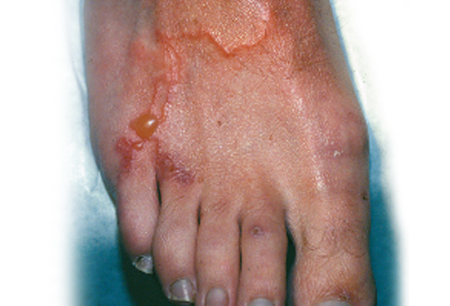Resumo
Definição
História e exame físico
Principais fatores diagnósticos
- viagem recente aos trópicos ou subtrópicos
- banhistas descalços/que tomam banho de sol
- rastro eritematoso elevado e serpiginoso
- prurido intenso
Outros fatores diagnósticos
- lesões vesiculobolhosas ou papulares
- foliculite
Fatores de risco
- residência ou viagem recente para uma área endêmica
- andar descalço e/ou tomar banho de sol em praia contaminada
Investigações diagnósticas
Primeiras investigações a serem solicitadas
- nenhum exame é necessário: o diagnóstico é clínico.
Investigações a serem consideradas
- raspagem/biópsia de pele
Novos exames
- microscopia de epiluminescência
Algoritmo de tratamento
adultos não gestantes e crianças
gestante
sem resposta ao tratamento inicial ou recidiva dos sintomas
Colaboradores
Autores
David J. Diemert, MD, FRCP(C)

Professor
Departments of Medicine and Microbiology, Immunology and Tropical Medicine
The George Washington University School of Medicine and Health Sciences
Washington
DC
Declarações
DJD declares that he has no competing interests.
Revisores
Eric Caumes, MD
Professor of Infectious and Tropical Diseases
Universite Pierre et Marie Curie
Vice Chairman
Department of Infectious and Tropical Diseases
Hopital Pitie-Salpetriere
Paris
France
Declarações
EC is an author of a number of references cited in this topic.
Jorg Heukelbach, MD, PhD
Professor
Department of Community Health
School of Medicine
Federal University of Ceara
Ceara
Brazil
Declarações
JH is an author of a number of references cited in this topic.
Jill Weatherhead, MD, PhD, CTropMed
Assistant Professor of Pediatric Tropical Medicine
Baylor College of Medicine
Houston
TX
Declarações
JW declares that she has no competing interests.
Créditos aos pareceristas
Os tópicos do BMJ Best Practice são constantemente atualizados, seguindo os desenvolvimentos das evidências e das diretrizes. Os pareceristas aqui listados revisaram o conteúdo pelo menos uma vez durante a história do tópico.
Declarações
As afiliações e declarações dos pareceristas referem--se ao momento da revisão.
Referências
Principais artigos
Feldmeier H, Schuster A. Mini review: hookworm-related cutaneous larva migrans. Eur J Clin Microbiol Infect Dis. 2012 Jun;31(6):915-8. Resumo
Tremblay A, MacLean JD, Gyorkos T, et al. Outbreak of cutaneous larva migrans in a group of travellers. Trop Med Int Health. 2000 May;5(5):330-34.Texto completo Resumo
Davies HD, Sakuls P, Keystone JS. Creeping eruption. A review of clinical presentation and management of 60 cases presenting to a tropical disease unit. Arch Dermatol. 1993 May;129(5):588-91. Resumo
Reichert F, Pilger D, Schuster A, et al. Epidemiology and morbidity of hookworm-related cutaneous larva migrans (HrCLM): Results of a cohort study over a period of six months in a resource-poor community in Manaus, Brazil. PLoS Negl Trop Dis. 2018 Jul 19;12(7):e0006662.Texto completo Resumo
Heukelbach J, Feldmeier H. Epidemiological and clinical characteristics of hookworm-related cutaneous larva migrans. Lancet Infect Dis. 2008 May;8(5):302-9. Resumo
Blackwell V, Vega-Lopez F. Cutaneous larva migrans: clinical features and management of 44 cases presenting in the returning traveller. Br J Dermatol. 2001 Sep;145(3):434-7. Resumo
Caumes E, Carrière J, Datry A, et al. A randomized trial of ivermectin versus albendazole for the treatment of cutaneous larva migrans. Am J Trop Med Hyg. 1993 Nov;49(5):641-4. Resumo
Artigos de referência
Uma lista completa das fontes referenciadas neste tópico está disponível para os usuários com acesso total ao BMJ Best Practice.

Diagnósticos diferenciais
- Larva currens
- Gnatostomíase
- Fasciolíase
Mais Diagnósticos diferenciaisConectar-se ou assinar para acessar todo o BMJ Best Practice
O uso deste conteúdo está sujeito ao nosso aviso legal